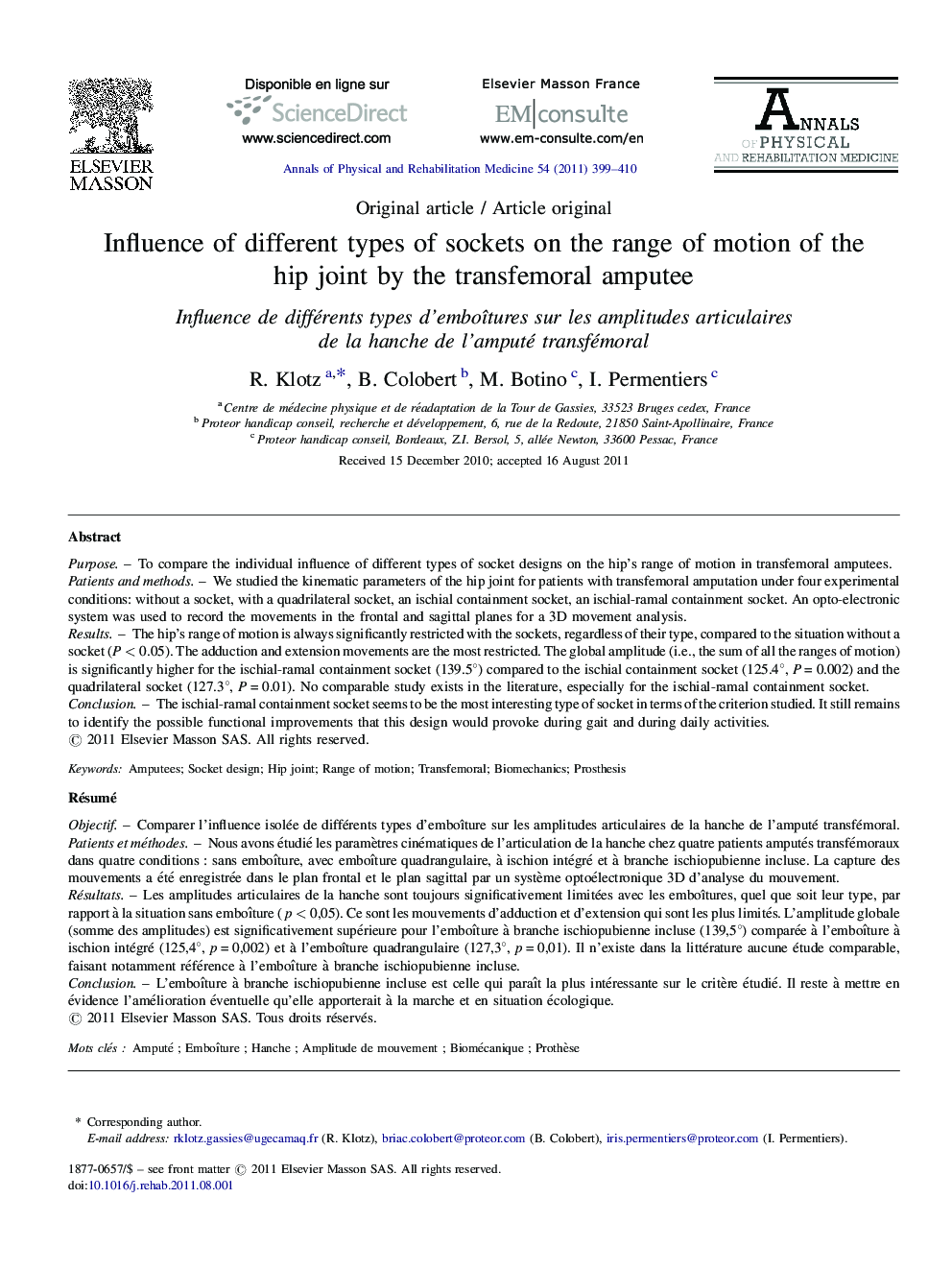| کد مقاله | کد نشریه | سال انتشار | مقاله انگلیسی | نسخه تمام متن |
|---|---|---|---|---|
| 4041282 | 1603334 | 2011 | 12 صفحه PDF | دانلود رایگان |

PurposeTo compare the individual influence of different types of socket designs on the hip's range of motion in transfemoral amputees.Patients and methodsWe studied the kinematic parameters of the hip joint for patients with transfemoral amputation under four experimental conditions: without a socket, with a quadrilateral socket, an ischial containment socket, an ischial-ramal containment socket. An opto-electronic system was used to record the movements in the frontal and sagittal planes for a 3D movement analysis.ResultsThe hip's range of motion is always significantly restricted with the sockets, regardless of their type, compared to the situation without a socket (P < 0.05). The adduction and extension movements are the most restricted. The global amplitude (i.e., the sum of all the ranges of motion) is significantly higher for the ischial-ramal containment socket (139.5°) compared to the ischial containment socket (125.4°, P = 0.002) and the quadrilateral socket (127.3°, P = 0.01). No comparable study exists in the literature, especially for the ischial-ramal containment socket.ConclusionThe ischial-ramal containment socket seems to be the most interesting type of socket in terms of the criterion studied. It still remains to identify the possible functional improvements that this design would provoke during gait and during daily activities.
RésuméObjectifComparer l’influence isolée de différents types d’emboîture sur les amplitudes articulaires de la hanche de l’amputé transfémoral.Patients et méthodesNous avons étudié les paramètres cinématiques de l’articulation de la hanche chez quatre patients amputés transfémoraux dans quatre conditions : sans emboîture, avec emboîture quadrangulaire, à ischion intégré et à branche ischiopubienne incluse. La capture des mouvements a été enregistrée dans le plan frontal et le plan sagittal par un système optoélectronique 3D d’analyse du mouvement.RésultatsLes amplitudes articulaires de la hanche sont toujours significativement limitées avec les emboîtures, quel que soit leur type, par rapport à la situation sans emboîture (p < 0,05). Ce sont les mouvements d’adduction et d’extension qui sont les plus limités. L’amplitude globale (somme des amplitudes) est significativement supérieure pour l’emboîture à branche ischiopubienne incluse (139,5°) comparée à l’emboîture à ischion intégré (125,4°, p = 0,002) et à l’emboîture quadrangulaire (127,3°, p = 0,01). Il n’existe dans la littérature aucune étude comparable, faisant notamment référence à l’emboîture à branche ischiopubienne incluse.ConclusionL’emboîture à branche ischiopubienne incluse est celle qui paraît la plus intéressante sur le critère étudié. Il reste à mettre en évidence l’amélioration éventuelle qu’elle apporterait à la marche et en situation écologique.
Journal: Annals of Physical and Rehabilitation Medicine - Volume 54, Issue 7, October 2011, Pages 399–410